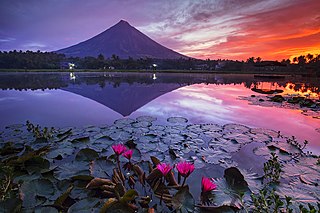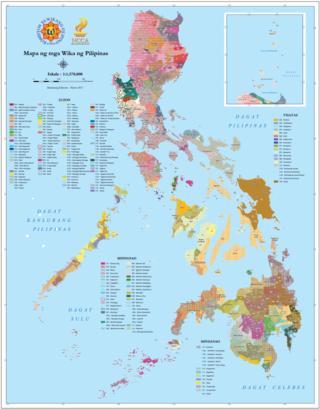
Albay, officially the Province of Albay, is a province in the Bicol Region of the Philippines, mostly on the southeastern part of the island of Luzon. Its capital is the city of Legazpi, the regional center of the whole Bicol Region, which is located in the southern foothill of Mayon Volcano.

Catanduanes, officially the Province of Catanduanes, is an island province located in the Bicol Region of Luzon in the Philippines. It is the 12th-largest island in the Philippines, and lies to the east of Camarines Sur, across the Maqueda Channel. Its capital is Virac, the most populous town in the province. It had a population of 271,879 people as of the 2020 census.

The Bicol Region, designated as Region V, is an administrative region of the Philippines. It comprises six provinces, four on the Bicol Peninsula : Albay, Camarines Norte, Camarines Sur, and Sorsogon, and two off the shore: Catanduanes and Masbate.

There are some 130 to 195 languages spoken in the Philippines, depending on the method of classification. Almost all are Malayo-Polynesian languages native to the archipelago. A number of Spanish-influenced creole varieties generally called Chavacano along with some local varieties of Chinese are also spoken in certain communities. The 1987 constitution designates Filipino, a standardized version of Tagalog, as the national language and an official language along with English. Filipino is regulated by Commission on the Filipino Language and serves as a lingua franca used by Filipinos of various ethnolinguistic backgrounds.
Tagalog grammar are the rules that describe the structure of expressions in the Tagalog language, one of the languages in the Philippines.

The Ivatan language, also known as Chirin nu Ivatan, is an Austronesian language spoken in the Batanes Islands of the Philippines.

Masbateño or Minasbate is a member of Central Philippine languages and of the Bisayan subgroup of the Austronesian language family spoken by more than 724,000 people in the province of Masbate and some parts of Sorsogon in the Philippines. Masbatenyo is the name used by the speakers of the language and for themselves, although the term Minásbate is sometimes also used to distinguish the language from the people. It has 350,000 speakers as of 2002, with 50,000 who speak it as their first language. About 250,000 speakers use it as their second language.
Rapa is the language of Rapa Iti, in the Austral Islands of French Polynesia, and of Mangaia in the Cook Islands. It is an Eastern Polynesian language. There are three varieties of the Rapa language currently being spoken in French Polynesia: Old Rapa, Reo Rapa and New Rapa. Old Rapa has been mostly replaced by Reo Rapa, a mix of the more commonly spoken Tahitian and Old Rapa. New Rapa – revitalized Old Rapa – is commonly spoken by middle-aged and younger speakers. Rapa is a critically endangered language, and there are only around 300 speakers of Reo Rapa, with only 15% of them able to speak Old Rapa. It may be more vibrant on Mangaia, but there the population has been declining for half a century due to emigration.

Pandan, officially the Municipality of Pandan, is a 4th class municipality in the province of Catanduanes, Philippines. According to the 2020 census, it has a population of 21,473 people.
Oroha, categorized as an Austronesian language, is one of many languages spoken by Melanesian people in the Solomon Islands. It is also known as Maramasike, Mara Ma-Siki, Oraha, and Oloha, and is used primarily in the southern part of Malaita Island within the Malaita Province. Little Mala is composed of three indigenous languages of the 'Tolo' people which are Na’oni, Pau, and Oroha. They are all slightly different, yet come from the same origin. The three languages may be thought of as different dialects of the same language. The three Tolo villages now harbor schools under the Melanesian Mission.

Central Bikol, commonly called Bikol Naga or simply as Bikol, is an Austronesian language spoken by the Bicolanos, primarily in the Bicol Region of southern Luzon, Philippines. It is spoken in the northern and western part of Camarines Sur, second congressional district of Camarines Norte, eastern part of Albay, northeastern part of Sorsogon, San Pascual town in Masbate, and southwestern part of Catanduanes. Central Bikol speakers can be found in all provinces of Bicol and it is a majority language in Camarines Sur. The standard sprachraum form is based on the Canaman dialect.
Ilocano grammar is the study of the morphological and syntactic structures of the Ilocano language, a language spoken in the northern Philippines by ethnic Ilocanos and Ilocano communities in other parts of the Philippines, especially in Mindanao and overseas such as the United States, Canada Australia, the Middle East and other parts of the world.
Ughele is an Oceanic language spoken by about 1200 people on Rendova Island, located in the Western Province of the Solomon Islands.

Rinconada Bikol or simply Rinconada, spoken in the province of Camarines Sur, Philippines, is one of several languages that compose the Inland Bikol group of the Bikol macrolanguage. It belongs to the Austronesian language family that also includes most Philippine languages, the Formosan languages of Taiwanese aborigines, Malay, the Polynesian languages and Malagasy.
Mara is a Kuki-Chin language spoken by Mara people, mostly the Tlosai tribe living in 30 villages of Chhimtuipui district, southern Mizoram, India and the adjacent villages in Burma.
"Tar Pit" is the first episode of the second season of the 1975 American television series Land of the Lost. Written by Margaret Armen and directed by Gordon Wiles, it first aired in the United States on September 6, 1975 on NBC.
Tawala is an Oceanic language of the Milne Bay Province, Papua New Guinea. It is spoken by 20,000 people who live in hamlets and small villages on the East Cape peninsula, on the shores of Milne Bay and on areas of the islands of Sideia and Basilaki. There are approximately 40 main centres of population each speaking the same dialect, although through the process of colonisation some centres have gained more prominence than others.
Lewo is an Oceanic language spoken on Epi Island, in Vanuatu.

The Ibanag language is an Austronesian language spoken by up to 500,000 speakers, most particularly by the Ibanag people, in the Philippines, in the northeastern provinces of Isabela and Cagayan, especially in Tuguegarao, Solana, Abulug, Camalaniugan, Lal-lo, Cabagan, Tumauini, San Pablo, Sto. Tomas, Sta. Maria, and Ilagan and other neighboring towns and villages around the Cagayan River and with overseas immigrants in countries located in the Middle East, United Kingdom, and the United States. Most of the speakers can also speak Ilocano, the lingua franca of northern Luzon island. The name Ibanag comes from the prefix I which means 'people of', and bannag, meaning 'river'. It is closely related to Gaddang, Itawis, Agta, Atta, Yogad, Isneg, and Malaweg.

The Karay-a language is an Austronesian regional language in the Philippines spoken by the Karay-a people, mainly in Antique.










